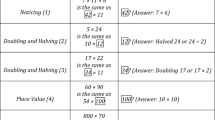Abstract
In our exploration of the order of operations we focus on the following claim: “In the conventional order of operations, division should be performed before multiplication.” This initially surprising claim is based on the acronym BEDMAS, a popular mnemonic used in Canada to assist students in remembering the order of operations. The claim was voiced by a teacher and then presented for consideration to a class of prospective elementary school teachers. We investigate the participants’ understanding of the order of operations, focusing on the operations of multiplication and division. We report on participants’ ways of resolving a cognitive conflict faced as a result of relying on memorized mnemonics.


Similar content being viewed by others
Notes
We also came across POMDAS and PODMAS in our searches, in which the “O” stands for “order.” We further learned that PEMDAS is often used in Francophone Canada.
References
Ameis, J. A. (2011). The truth about PEMDAS. Mathematics Teaching in the Middle School, 16(7), 414–420.
Bachelard, G. (1938/1986). The formation of the scientific mind: A contribution to a psychoanalysis of objective knowledge. Boston: Beacon Press.
Bachelard, G. (2002). The formation of the scientific mind. Manchester: Clinamen Press.
Bay-Williams, J. M., & Martinie, S. L. (2015). Order of operations: The myth and the math. Teaching Children Mathematics, 22(1), 20–27.
Blando, J. A., Kelly, A. E., Schneider, B. R., & Sleeman, D. (1989). Analyzing and modeling arithmetic errors. Journal of Research in Mathematics Education, 20(3), 301–308.
Chernoff, E., & Zazkis, R. (2011). From personal to conventional probabilities: From sample set to sample space. Educational Studies in Mathematics, 77(1), 15–33.
Dupree, K. M. (2016). Questioning the order of operations. Mathematics Teaching in the Middle School, 22(3), 152–159.
Erlwanger, S. (1973). Benny’s conception of rules and answers in IPI Mathematics. Journal of Children’s Mathematical Behavior, 1, 7–26.
Flavell, J. H. (1977). Cognitive development. Englewood Cliffs, NJ: Prentice-Hall.
Glidden, P. L. (2008). Prospective elementary teachers’ understanding of order of operations. School Science and Mathematics, 108(4), 130–136.
Herscovics, N. (1989). Cognitive obstacles encountered in the learning of algebra. In C. Kieran & S. Wagner (Eds.), Research issues in the learning and teaching of algebra (pp. 60–86). Hillsdale, NJ: Lawrence Erlbaum Associates.
Hewitt, D. (1999). Arbitrary and necessary: A way of viewing the mathematics curriculum. For the Learning of Mathematics, 19(3), 2–9.
Hewitt, D. (2012). Young students learning formal algebraic notation and solving linear equations: Are commonly experienced difficulties avoidable? Educational Studies in Mathematics, 81(2), 139–159.
Jeon, K. (2012). Reflecting on PEMDAS. Teaching Children Mathematics, 18(6), 370–377.
Kalder, R. S. (2012). Are we contributing to our students’ mistakes? Mathematics Teacher, 106(2), 90–91.
Kontorovich, I., & Zazkis, R. (2017). Mathematical conventions: Revisiting arbitrary and necessary. For the Learning of Mathematics, 37(1).
Leikin, R., & Zazkis, R. (2010). Teachers’ opportunities to learn mathematics through teaching. In R. Leikin & R. Zazkis (Eds.), Learning through Teaching Mathematics: Developing teachers’ knowledge and expertise in practice (pp. 3–22). Dordrecht, Netherlands: Springer.
Linchevski, L., & Livneh, D. (1999). Structure sense: The relationship between algebraic and numerical contexts. Educational Studies in Mathematics, 40, 173–196.
Martin, L. C., & Towers, J. (2016). Folding back, thickening and mathematical met-befores. Journal of Mathematical Behavior, 47, 89–97.
McGowen, M., & Tall, D. (2010). Metaphor or met-before? The effects of previous experience on the practice and theory of learning mathematics. Journal of Mathematical Behavior, 29(3), 169–179.
Musser, G. L., Burger, W. F., & Paterson, B. E. (2006). Mathematics for elementary teachers: A contemporary approach. New York: Wiley.
Pappanastos, E., Hall, M. A., & Honan, A. S. (2002). Order of operations: Do business students understand the correct order? Journal of Education for Business, 78(2), 81–84.
Piaget, J. (1977). The development of thought: Equilibration of cognitive structures. New York: Viking.
Sierpinska, A. (1994). Understanding in mathematics. London: Falmer Press.
Shahbari, J. A., & Peled, I. (2015). Resolving cognitive conflict in a realistic situation with modeling characteristics: Coping with a changing reference in fraction. International Journal of Science and Mathematics Education, 13(4), 891–907.
Tall, D. (2013). How humans learn to think mathematically: Exploring the three worlds of Mathematics. New York, NY: Cambridge University Press.
Tirosh, D., & Graeber, A. O. (1990). Evoking cognitive conflict to explore preservice teachers’ thinking about division. Journal for Research in Mathematics Education, 21(2), 98–108.
Van de Walle, J. A., Folk, S., Karp, K. S. Bay-Williams, J. M. (2011). Elementary and middle school mathematics: Teaching developmentally. 3rd Canadian Edition. Toronto: Pearson Canada.
Watson, J. (2007). The role of cognitive conflict in developing students’ understanding of average. Educational Studies in Mathematics, 65(1), 21–47.
Watson, J. (2010). BODMAS, BOMDAS and DAMNUS. Cross Section, 20(4), 6–9.
Waxter, M., & Morton, J. B. (2011). Cognitive conflict and learning. In N. M. Seel (Ed.), Encyclopedia of the sciences of learning (pp. 585–587). New York: Springer.
Zaslavsky, O. (1997). Conceptual obstacles in the learning of quadratic functions. Focus on Learning Problems in Mathematics, 19(1), 20–44.
Zazkis, R. (2011). Relearning mathematics: A challenge for prospective elementary school teachers. Charlotte, NC: Information Age Publishing.
Zazkis, R., & Kontorovich, I. (2016). A curious case of superscript (−1): Prospective secondary mathematics teachers explain. Journal of Mathematical Behavior, 43, 98–110.
Zazkis, R., Liljedahl, P., & Gadowsky, K. (2003). Students’ conceptions of function translation: Obstacles, intuitions and rerouting. Journal of Mathematical Behavior, 22(4), 437–450.
Author information
Authors and Affiliations
Corresponding author
Rights and permissions
About this article
Cite this article
Zazkis, R., Rouleau, A. Order of operations: On convention and met-before acronyms. Educ Stud Math 97, 143–162 (2018). https://doi.org/10.1007/s10649-017-9789-9
Published:
Issue Date:
DOI: https://doi.org/10.1007/s10649-017-9789-9




